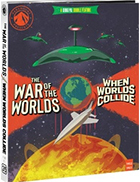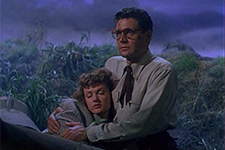| Director: Byron Haskin | | Screenplay: Barré Lyndon (based on the novel by H.G. Wells) | | Stars: Gene Barry (Dr. Clayton Forrester), Ann Robinson (Sylvia Van Buren), Les Tremayne (Maj. Gen. Mann), Bob Cornthwaite (Dr. Pryor), Sandro Giglio (Dr. Bilderbeck), Lewis Martin (Pastor Matthew Collins) | | MPAA Rating: G | | Year of Release: 1953 | | Country: U.S. |  |
|  Producer George Pal’s film version of H.G. Wells’s The War of the Worlds was quite a shock to audiences in the early 1950s, which is why it is described as frequently as a horror movie as it is as a science fiction movie. Despite coming on the heels of Allied victory in World War II and landing right in the midst of American economic prosperity and growing international power (with its concomitant increase in tension with the Soviet Union), the film did not play up our sense of security and strength. Rather, it functioned just as Wells intended: as a cautionary tale about the limits of human power. There had been science fiction movies before The War of the Worlds, even doomsday scenarios like Pal’s When Worlds Collide (1951) and Robert Wise’s cautionary fable The Day the Earth Stood Still (1951). Yet, neither of those films depicted with such simple brutality the human race completely at the mercy of foreign invaders, a genuine fear in the era of the Cold War. When Worlds Collide showed the destruction of planet Earth on an impressive scale, but it was under the thumb of a natural occurrence that couldn’t be stopped; The Day the Earth Stood Still suggested the power of an alien race to destroy us, but gave us the benefit of the doubt in the end. It reassured us that rationality and decency were paths to peace and survival. The War of the Worlds had no such pretensions; in fact, when people try to act benevolent toward the invading aliens, they are summarily annihilated. The film posits the idea that an alien race of “cool and unsympathetic” intelligence could invade the planet and destroy us with impunity. In fact, screenwriter Barré Lyndon (The Greatest Show on Earth) even upped the stakes by making the alien spacecraft literally impenetrable by all of humankind’s weapons, from machine guns, to tanks, to rocket launchers, to the most dreaded of all—the atomic bomb. Lyndon structured the story in terms of growing escalation, as meteors mysteriously crash on Earth and give way to humming, pulsating flying machines that show their vicious intentions by first vaporizing three yokels who wave a white flag and try to welcome the invaders to California and then by zapping a pastor trying to make peace by steadily approaching the craft and reciting the 23rd Psalm. If a man of God could be killed with such relentless impunity, what chance did the rest of us stand? In its images of destruction and mayhem, The War of the Worlds is a near masterpiece. Especially given the limits of special effects technology in the early 1950s and the film’s limited budget (it was shot almost entirely on a single soundstage), the resulting imagery is undeniably impressive. The manta-like flying ships, which are given additional anthropomorphic creepiness by a snake-like extension at the top from which the heat rays are shot, cruise slowly and methodically through the world’s most recognizable cities, laying waste to everything in their path. A montage shows destruction taking place throughout the world (except the Soviet Union, which curiously goes unmentioned), but the focus is on the firestorm in the United States, particularly southern California (perhaps a stroke of Hollywood masochism?). The imagery of an American city ravaged by war and in flames, something that hadn’t happened since the Civil War, is as potent today as it was 50 years ago. Of course, in his zeal to give The War of the Worlds the grandest possible stage, director Byron Haskin (Robinson Crusoe on Mars) and screenwriter Barré Lyndon largely ignore the humanity that’s being destroyed. More to the point, they take humanity for granted, which results in dull, cardboard characters who are more archetypes than human beings. Most of the characters are scientists and military men (typical of sci-fi in the 1950s), and the story ends up centering around an intelligent, but sensitive scientist (Gene Barry) and the young woman who fawns over him (Ann Robinson). The filmmakers’ decision to use unknown actors so that star wattage wouldn’t get in the way of the breadth of the alien invasion was a good move, but they should have paid more attention to the way the characters were developed. If The War of the Worlds had had an effective human core, one that put a face on its epic of death and destruction, it might very well have reached a pinnacle of true greatness. | The War of the Worlds / When Worlds Collide “Paramount Presents” 4K UHD / Blu-ray Two-Disc Set | | | Aspect Ratio | 1.37:1 (both films) | | Audio | The War of the Worlds
English DTS-HD Master Audio 5.1 surroundFrench Dolby Digital 1.0 monauralWhen Worlds Collide
English DTS-HD Master Audio 5.1 surroundGerman Dolby Digital 1.0 monauralSpanish Dolby Digital 1.0 monauralFrench Dolby Digital 1.0 monaural | | Subtitles | The War of the Worlds: English, English SDH, French, German, Italian, Japanese, Spanish, Dutch / When Worlds Collide: English, English SDH, French, German, Japanese, Spanish | | Supplements | The War of the Worlds
Audio commentary by actors Ann Robinson and Gene BarryAudio commentary by film director Joe Dante, film historian Bob Burns, and Bill Warren, author of Keep Watching The Skies!“The Sky Is Falling: Making The War of the Worlds” documentary“H.G. Wells: The Father of Science Fiction” featuretteThe Mercury Theatre On The Air presents “The War of the Worlds” radio broadcastOriginal theatrical trailerWhen Worlds Collide
Original theatrical trailer | | Distributor | Paramount Home Entertainment | | Release Date | September 27, 2022 | | | COMMENTS | | The War of the Worlds and When Worlds Collide are each housed on a separate disc in Paramount’s “George Pal Double Feature” set, with the former debuting on 4K UHD and the latter on Blu-ray. The 4K presentation of The War of the Worlds derives from the same 2018 restoration that was used for The Criterion Collector’s Blu-ray release a few years ago, in which the original Technicolor three-strip negatives were scanned in 4K and restored. Criterion’s Blu-ray was a striking improvement over Paramount’s 2005 DVD, and this 2160p/Dolby Vision UHD presentation give us an even more vivid reproduction of the ’50s Technicolor experience. Colors are slightly brighter and more saturated, and visual detail and texture gets a boost. Like the Criterion disc, the image is free of dust, scratches, and wear (some shots are noticeably softer than others, but this is inherent to the original elements). Note has to be made, though, of a major, major error in one of the film’s first shots where the planet Mars looks decidedly blue, rather than predominantly red as it was intended. This appears to be an error in the original scan and one that Criterion corrected for their release, but was inexplicably left on Paramount’s. As for When Worlds Collide, its high-definition presentation appears to have come from the same source as the 2020 region-free Imprint Blu-ray, but from what I have seen in comparing this disc with screen caps I’ve seen online from Imprint’s, the two transfers look quite different. Paramount’s transfer is somewhat duller than Imprint’s, with whites leaning a tad yellowish while Imprint’s are bright and slightly bluish. Color overall appears a bit faded and not at all as vibrant as you might expect from a ’50s Technicolor film. Perhaps this was a purposeful choice in the color grading (maybe to make it look a bit more realistic?), but it seems odd. In terms soundtracks, both films sport newly prepared 5.1-channel mixes presented in DTS-HD Master Audio. For The War of the Worlds, master sound designer Ben Burtt (Star Wars, WALL•E) was brought in to create the six-channel mix using the preservation magnetic tracks, several single-strip monaural music cues, and archival sound effects from Burtt’s own library. The result is quite impressive, especially given that Burtt had to essentially rebuild parts of the soundtrack. The surround effects really work, with good space and directionality, which heightened the Martian invaders’ otherworldly noises and produces some startling moments (when the meteor started “unscrewing,” the sound is located firmly over your left shoulder and made me jump). There is also a great deal more weight to the track, with the newly added LFE channel giving the explosions, crashing buildings, and atomic detonation some real power. The six-channel soundtrack for When Worlds Collide also sounds very good, with some nice directionality and depth, especially in the destruction sequences in the film’s second half that are given a solid boost with the LFE track. On The War of the Worlds, all of the supplements date back to Paramount’s 2005 DVD. There are two audio commentaries: The first, by actors Gene Barry and Ann Robinson, is definitely the lesser of the two, although it is still worth a spin. The second track, by fan/film director Joe Dante (Gremlins), film historian Bob Burns, and sci-fi expert Bill Warren (author of Keep Watching the Skies!, one of the definitive books on science fiction), is definitely worth a listen, as they offer all kinds of interesting insight into the film and the lore surrounding it. More information about the film can be found in “The Sky is Falling: Making The War of the Worlds,” a first-rate 30-minute retrospective featurette that features interviews with a wide range of participants, from actor Gene Barry, to assistant director Mickey Moore, to special effects guru Al Nozaki (who, having passed away, is seen only in archival video footage). Some of the highlights include Ray Harryhausen’s stop-motion animation tests for the Martians, some hilarious stories about the creation of the Martian suit, and a bit about how George Pal used to always slip Woody Woodpecker into his movies (yes, he’s in The War of the Worlds). The shorter featurette “H.G. Wells: The Father of Science Fiction,” which runs about 10 minutes, gives a brief rundown of the life of the great sci-fi innovator. A nice inclusion is the complete Mercury Theatre radio broadcast of The War of the Worlds, which starred Orson Welles and famously sent some people running for the hills when they mistook it for the real deal. There is also an original theatrical trailer. On the When Worlds Collide disc, the only supplement is a trailer, which is a real disappointment given that the Imprint Blu-ray was stacked with material. |
Copyright © 2022 James Kendrick Thoughts? E-mail James Kendrick All images copyright © Paramount Home Entertainment |



 (3)
(3)

